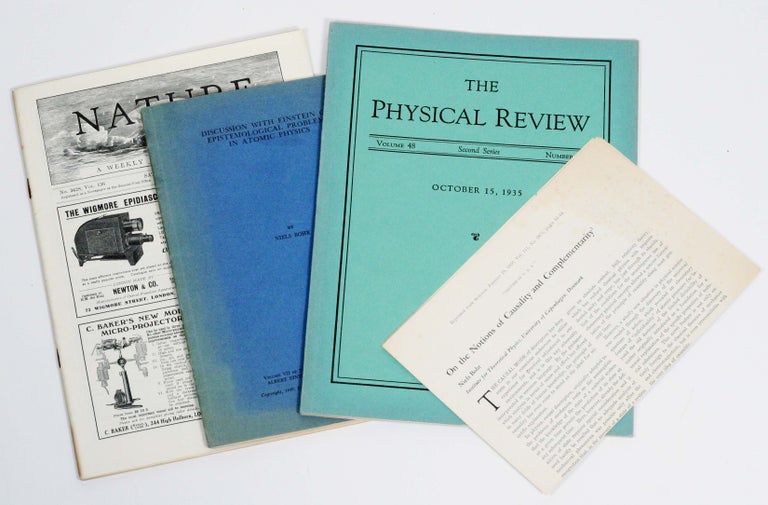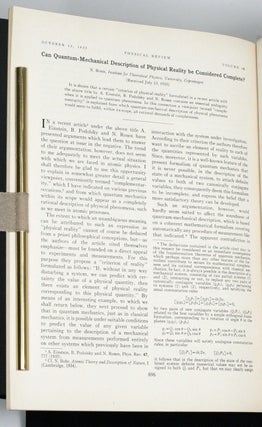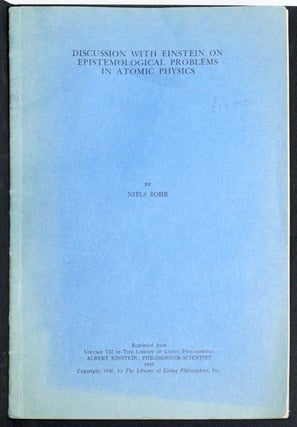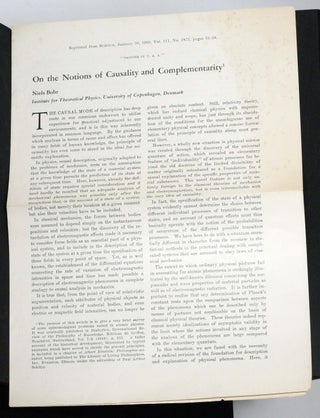Letter to the Editor of Nature (13 July, 1935); “Can the Quantum Mechanical Description of Physical Reality be Considered Complete?”, in Physical Review (1935); “Discussion with Einstein on Epistemological Problems in Atomic Physics”, offprint from Albert Einstein: Philosopher-Scientist (1949); “On Notions of Causality and Complementarity”, offprint from Science (1950)
“[W]hen [Einstein] came to Copenhagen, I naturally fetched him from the railway station. […] [W]e took the street car from the station and talked so animatedly about things that we went much too far past our destination. So we got off and went back. Thereafter we again went too far, I can’t remember how many stops, but we rode back and forth in the street car because Einstein was really interested at that time; we don’t know whether his interest was more or less skeptical—but in any case we went back and forth many times in the street car and what people thought of us, that is something else.”
– Niels Bohr, in a 1961 interview, quoted in Pais, p. 229
IMPORTANT PAPERS BY NIELS BOHR CONCERNING HIS DEBATES WITH ALBERT EINSTEIN OVER FOUNDATIONAL ISSUES IN QUANTUM MECHANICS.
From the mid-1920s to the mid-1930s, at scientific conferences, in published papers and in informal discussions, two of the greatest physicists of their generation—Albert Einstein and Niels Bohr—argued about the emerging theory of quantum mechanics. Quantum theory had been phenomenally successful in explaining experimental results that had puzzled physicists for decades, and in accurately predicting new results. No one denied its predictive power, least of all Einstein who had been one of the early pioneers of the theory. However, the interpretation of the theory—the elucidation of its relationship to some (presumably) underlying physical reality—was a different matter.
Quantum theory predicted only the probabilities of various experimental outcomes. Of course, probabilistic (or statistical) models of nature were nothing new to physicists. In the nineteenth century, Ludwig Boltzmann and others had developed the theory of statistical mechanics, which was concerned with predicting the bulk thermodynamic properties of materials through a statistical analysis of the motions of large ensembles of molecules, without attempting the impossible task of measuring or predicting the motion of each individual molecule. In statistical mechanics, the results were understood to be mere summaries of a more detailed underlying reality that was, as a practical matter, inaccessible to experimental observation.
The question raised by quantum theory was whether its predictions merely reflected an incomplete knowledge of the underlying physical systems, as with statistical mechanics, or whether quantum systems were statistical (or probabilistic) in a more fundamental and ontological sense. Put another way, was the underlying reality itself probabilistic, or were there “hidden variables”—like the motions of individual molecules in statistical mechanics—which, even if not experimentally accessible, explained the rules of the theory? Bohr advanced the former view, and made it one of the fundamental pillars of the so-called “Copenhagen interpretation” of quantum theory that is associated with him and his followers.
Initially, Einstein seemed willing to accept some elements of what later became solidified as the Copenhagen interpretation. “In 1905 Einstein had proposed that under certain circumstances monochromatic light […] behaves as if it consists of light quanta, photons, particle-like objects” (Pais, p. 230). In trying to reconcile his proposal with the traditional wave theory of light, Einstein, in a 1909 paper, stated, “Deshalb ist es meine Meinung, daß die nächste Phase der Entwicklung der theoretischen Physik uns eine Theorie des Lichtes bringen wird, welche sich als eine Art Verschmelzung von Undulations- und Emissionstheorie des Lichtes auffassen läßt.” [Therefore it is my opinion that the next phase of in the development of theoretical physics will bring us a theory of light that can be understood as a sort of fusion of the wave and particle theories light.] (Einstein, p. 817). Such a “profound statement”, writes Bohr’s assistant and later college of Einstein’s, Abraham Pais, “foreshadows the fusion achieved in quantum mechanics—the new mechanics so offensive to Einstein’s later views.” (Pais, p. 231).
But when physicists began to take sides on Bohr’s emerging theory of complementarity, Einstein joined Schrödinger, Planck and others who were unable to accept the view of the natural world that was implicit in the Copenhagen interpretation. (Schrödinger’s best-known contribution to the debate was his famous “Schrödinger’s cat” thought experiment. Heisenberg, on the other hand, sided with Bohr.) These disputes became a focus of the Fifth Solvay Conference on Physics, held in Brussels in 1927. “All the creators of both the old and the new quantum theory were in attendance. The general discussion was opened by the venerable Lorentz, president of the meeting, who asked: ‘Could one not maintain determinism by making it an article of faith? Must one necessarily elevate indeterminism to a principle?’” (Pais, 425–26).
“[Einstein’s] reservations [concerning quantum theory] were twofold. Firstly, he felt the theory had abdicated the historical task of natural science to provide knowledge of significant aspects of nature that are independent of observers or their observations. Instead the fundamental understanding of the quantum wave function […] was that it only treated the outcomes of measurements (via probabilities given by the Born Rule). The theory was simply silent about what, if anything, was likely to be true in the absence of observation. That there could be laws, even probabilistic laws, for finding things if one looks, but no laws of any sort for how things are independently of whether one looks, marked quantum theory as irrealist. Secondly, the quantum theory was essentially statistical. The probabilities built into the state function were fundamental and, unlike the situation in classical statistical mechanics, they were not understood as arising from ignorance of fine details. In this sense the theory was indeterministic. Thus Einstein began to probe how strongly the quantum theory was tied to irrealism and indeterminism.” (Stanford Encyclopedia of Philosophy). As Einstein saw it, the only way to preserve realism and determinism was to assume that quantum theory, successful as it was empirically, was not a “complete” theory of nature, and that there must be hidden variables affecting the experimental outcomes that would have to be included in any complete theory (even if they were not experimentally observable).
The two pairs of papers offered here provide important documentation, from Bohr’s perspective, of the Bohr-Einstein debate.
I. Bohr’s Reaction to the EPR Paper—Letter to the Editor of Nature (July 13, 1935) and “Can the Quantum Mechanical Description of Physical Reality be Considered Complete?”, in Physical Review (1935)
“In the May 15, 1935 issue of Physical Review Albert Einstein co-authored a paper with his two postdoctoral research associates at the Institute for Advanced Study, Boris Podolsky and Nathan Rosen. The article was entitled ‘Can Quantum Mechanical Description of Physical Reality Be Considered Complete?’ […] Generally referred to as EPR, this paper quickly became a centerpiece in debates over the interpretation of quantum theory, debates that continue today. Ranked by impact, EPR is among the top ten of all papers ever published in Physical Review journals.” (Stanford Encyclopedia of Philosophy).
Indeed, like the verification of Einstein’s earlier prediction of the gravitational deflection of light, EPR even got attention in the popular press. Eleven days before the paper was published: “The New York Times carried an extensive report under the provocative headline ‘Einstein Attacks Quantum Theory,’ which was summarized by the sentences: ‘Professor Einstein will attack science’s important theory of quantum mechanics, a theory of which he was sort of grandfather. He concluded that while it [the quantum mechanics], is “correct” it is not “complete.”’” (Mehra and Rechenberg, p. 724–25).
In essence, Einstein and his collaborators devised a thought-experiment involving two physical systems (say, A and B) with necessarily-correlated physical properties, that were widely separated in space. (For example, the two systems might have equal and opposite momenta and positions dictated by physical conservation laws.) From the perspective of quantum theory, the two systems could be described by a single wave function, or state vector. A measurement performed on A could precisely determine its position, which would also fix a precise position for B. The momenta of A and B could be determined in the same way. The central insight of EPR was that either the position and momentum of A and B were real, determinate and fixed prior to the measurement of A, or else B only took on a fixed and determinate value when A was measured. But the latter interpretation implied that the measurement event at A had somehow instantaneously fixed the (previously indeterminate) properties of B, despite the spatial separation between A and B, which could be made as great as one wished. Einstein argued that this implied one of two things: either that the quantum description of A and B was incomplete, in that each of them had a fixed, determinate position and momentum at all times; or that nature permitted actions such as measurement to have “nonlocal” influences on distant systems.
In the first two items offered here, Bohr responds to the EPR argument. The first, shorter version of the response appeared as a letter to the editor in the journal Nature; the second, a more developed discussion, appeared shortly thereafter as a full-fledged scientific paper in Physical Review.
Leon Rosenfeld, who was in Copenhagen at the time, remembered the fallout of these developments vividly: “This onslaught came down upon as a bolt from the blue […] As soon as Bohr heard my report of Einstein’s argument, everything else was abandoned: we had to clear up such a misunderstanding at once.” (Pais, 430). According to Rosenfeld, the next day Bohr was heard muttering “Podolski, Opodolski, Iopodolski,” etc. By mocking Podolsky—who was, after all, only a postdoctoral student and the second-named author of EPR—Bohr presumably was, even in his anger, avoiding saying anything that might be interpreted as a direct attack on Einstein.
Bohr’s argument proceeded with what some might describe as his characteristic lack of explanatory clarity. Indeed, in revisiting EPR fifteen years later, Bohr himself would admit, “[r]ereading these passages, I am deeply aware of the inefficiency of expression which must have made it very difficult to appreciate the trend of the argumentation” (Schilpp, p. 234; see also Lehner, p. 331, who describes Bohr’s rebuttal of EPR as “obscure in content but confident in tone.”). Generally speaking, however, Bohr’s approach seems to boil down to a willingness to accept non-local or “contextual” theory of measurement interactions. In any event, it is clear that Bohr was more prepared than Einstein was to take quantum theory at face value as a complete theory, even if this meant abandoning notions of physical reality that are part of humanity’s intuitive understanding of the world.
Later in a famous 1964 paper, John Bell, using an EPR-like thought experiment, proved that the situation was even worse than Einstein had imagined: even a hidden variable theory that reproduced the empirical predictions of quantum mechanics would necessarily violate Einstein’s desideratum of local realism. As Christoph Lehner puts it, “this proof is of great importance because it shows the impossibility of Einstein’s idea that quantum mechanics could be understood as an incomplete description of a reality that is objective and locally definite.” (Lehner, p. 234).
II. Bohr’s Contribution to Albert Einstein: Philosopher-Scientist—“Discussion with Einstein on Epistemological Problems in Atomic Physics”, offprint from Albert Einstein: Philosopher-Scientist (1949) and “On Notions of Causality and Complementarity”, offprint from Science (1950)
From the 1930s through to the present, the publishing enterprise The Library of Living Philosophers has sought to “bring together,” for “each of the greater of the world’s living philosophers,” “the interpretations and criticisms of a wide range of that particular thinker’s scholarly contemporaries, each of whom will be given a free hand to discuss the specific phase of the thinker’s work which has been assigned to him. All contributed essays will finally be submitted to the philosopher with whose work and thought they are concerned, for his careful perusal and reply.”(Schilpp (ed.), p. vii). The seventh volume in the series, edited by Paul Arthur Schilpp and published in 1949, was devoted to Albert Einstein, the “Philosopher-Scientist”, and included contributions from Bohr, Pauli, de Broglie, Born, Gödel, and numerous other luminaries.
Bohr’s contribution to this Festschrift, the offprint of which is offered here, was titled “Discussion with Einstein on Epistemological Problems in Atomic Physics.” His forty-page discussion runs through the entire history of his discussions with Einstein on foundational issues. Its opening words, written with uncharacteristic clarity and characteristic generosity, state: “When invited by the editor of the series, 'Living Philosophers', to write an article for this volume in which contemporary scientists are honouring the epoch-making contributions of Albert Einstein to the progress of natural philosophy and are acknowledging the indebtedness of our whole generation to the guidance his genius has given us, I thought much of the best way of explaining how much I owe to him for inspiration. In this connection, the many occasions through the years on which I had the privilege to discuss with Einstein epistemological problems raised by the modern development of atomic physics have come back vividly to my mind and I have felt that I could hardly attempt anything better than to give an account of these discussions which, even if no complete concord has so far been obtained, have been of greatest value and stimulus to me. I hope also that the account may convey to wider circles an impression of how essential the open-minded exchange of ideas has been for the progress in a field where new experience has time after time demanded a reconsideration of our views.” (Bohr, “Discussion with Einstein”, p. 201).
Einstein’s response to Bohr made it clear that his own position, like Bohr’s, had not changed: “What does not satisfy me in [quantum theory], from the standpoint of principle, is the attitude towards that which appears to me to be the programmatic aim of all physics: the complete description of any (individual) real situation (as it supposedly exists irrespective of any act of observation or substantiation).” (Einstein, “Reply to Criticism”, in Schlipp (ed.), pp. 667–74).
Towards the end of his 1949 discussion, Bohr notes that “[a]lthough in more recent years I have had several occasions of meeting Einstein, the continued discussions, from which I always have received new impulses, have so far not led to a common view about the epistemological problems in atomic physics, and our opposing views are perhaps most clearly stated in a recent issue of Dialectica.” (Bohr, “Discussion with Einstein”, p. 239). The Dialectica paper was reprinted in the journal Science in 1950, and an offprint of that reprint is also offered here.
It is most notable for its willingness to extend Bohr’s theory of complementarity in striking new directions. For example, at page 54, Bohr states that “[t]he complementary mode of description […] aims at an appropriate dialectic expression for the actual conditions of analysis and synthesis in atomic physics. […] The epistemological lesson we have received from the new development in physical science […] may also suggest lines of approach in other domains of knowledge. […] An example is offered in biology, where mechanistic and vitalistic arguments are used in a typically complementary manner. In sociology, too, such dialectics may often be useful. […] Recognition of complementary relationship is not least required in psychology, where the conditions for analysis and synthesis of experience exhibit striking analogy with the situation in atomic physics.”
BOHR, NIELS. “Letters to the Editor: Quantum Mechanics and Physical Reality”. IN: Nature, vol. 136, no. 3428 (13 July, 1935). Quarto, complete issue in original wrappers. Rusting around staples, as usual; otherwise, clean and bright pages.
BOHR, NIELS. “Can the Quantum-Mechanical Description of Physical Reality be Considered Complete?”. IN: Physical Review, vol. 48, no. 8 (15 October, 1935). Quarto, complete issue in original wrappers. Excellent condition.
BOHR, NIELS. “Discussion with Einstein on Epistemological Problems in Atomic Physics”. Offprint from: Volume VII of The Library of Living Philosophers, Albert Einstein: Philosopher-Scientist, 1949. Octavo, complete issue in original wrappers. Fading around edges, bookplate of Arnold W. Thackray, scientific historian and founding president of the Chemical Heritage Foundation, inscribed: “Cambridge July 1975”.
BOHR, NIELS. “On the Notions of Causality and Complementarity”. Reprinted from: Science, vol. 111, no. 2873 (20 January, 1950). Folio, one self-folding leaf comprising 4 pages. Light foxing on recto, not affecting text.
References:
Stanford Encyclopedia of Philosophy: Arthur Fine, “The Einstein-Podolsky-Rosen Argument in Quantum Theory”, The Stanford Encyclopaedia of Philosophy, ed. Edward N. Zalta (Online: Stanford University, 2020)
Einstein, Albert, “Über die Entwicklung unserer Anschauungen über das Wesen und die Konstitution der Strahlung” [On the Development of Our Views on the Nature and Constitution of Radiation], Physikalische Zeitschrift 10.22 (1909), 817–26
Lehner, Christoph, “Einstein’s Realism and His Critique of Quantum Mechanics”, in Michel Janssen and Christoph Lehner (eds.), The Cambridge Companion to Einstein (Cambridge: Cambridge University Press, 2014)
Mehra, Jagdish and Helmut Rechenberg, The Historical Development of Quantum Theory, 6 vols. (New York: Springer-Verlag, 1982–2001), VI: The Completion of Quantum Mechanics, 1926–1941 (2001)
Pais, Abraham, Niels Bohr’s Time: In Physics, Philosophy and Polity (Oxford: Clarendon Press, 1991)
Schilpp, Paul Arthur (ed.), Albert Einstein: Philosopher-Scientist (Evanston: Library of Living Philosophers, 1949).
Price: $6,750 .






